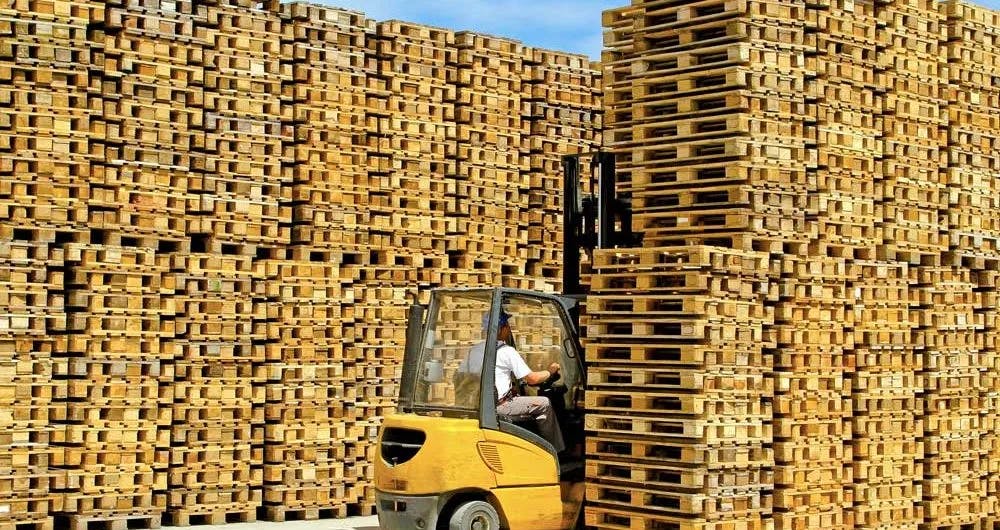What are Pallets?
A pallet is a horizontal platform typically affixed to a superstructure and a bottom deck. It supports goods in a stable fashion while being lifted by material handling equipment such as a forklift, a front loader, a jacking device, or an erect crane. The pallet provides the base for storing, assembling, handling, and transporting materials and products. Additionally, a pallet provides protection for the material on it.
The pallet is the most common base for the unit load. The unit load is an order or organization that includes the pallet and goods stacked atop it, as well as the stretch wrap, adhesive, pallet collar, or other means of unit load stabilization.
While most pallets are made of wood, they can also be made of plastic, metal, paper, or recycled materials. Each material has advantages and disadvantages.
Materials Used for Pallets
There are various kinds of pallet materials. Wood pallets dominate the marketplace, followed by other materials such as plastic, paper, and metal pallets.
Wood pallets combine important elements like weight, stiffness, durability, and cost. Also, there are a lot of pallet recycling organizations that help promote the recycling and refurbishment of wood pallets. Custom pallet sizes can be easily fabricated from timber components. Plastic pallets are typically more expensive than wood pallets for comparable applications but are valued for such attributes as extreme durability, precision of manufacture, and ease of sanitation. Other important factors in buying include pallet weight and considerations for export pallets, such as ISPM-15 compliance or exemption for international shipping.
Plastic is the second-most popular material used for pallets. Plastic pallets can be composed of a very strong, high-performance design or be inexpensive and lightweight, suitable for export. Non-timber pallets are not required to have ISPM-15 compliance. Therefore, they have become increasingly popular for export.
The Primary Pallet Sizes
Although pallets may be made to various custom sizes, there are some standard sizes that are commonly used. When describing the size of the pallets, one starts with the stringer or stringer board length first, followed by the pallet width, typically the length of the deck boards. The main pallet size or pallet dimension in North America is 48 x 40 inches. Here is a list of the six pallet sizes recognized by ISO, including the region most commonly used:
- 1219x1016 (48x40 inches) - North America
- 1000x1200 - Europe and Asia
- 1165x1165 - Australia
- 1067x1067 - North America, Europe, and Asia
- 1100x1100 - Asia
Working Safely with Pallets
Pallets are one of the most basic but important tools in the global supply chain. They can also be a hazard if you’re not careful. Pallets, if not carefully handled, can cause injuries such as puncture wounds, sprained ankles, or worse. With roughly 2 billion pallets circulating in the United States, it is important for material handlers to take some basic precautionary steps to avoid injury.
6 Tips for Pallet Safety
Handling pallets is a daily practice in many workplaces. Whether you are the employer or the employee, always make sure that the proper procedures are properly embraced.
Here are some of the safety measures for handling pallets:
Never use pallets as a man lift
For this purpose, use only approved, engineered lift platforms and only after having received and signed off on necessary training. A pallet should never be used as a manlift. Pallets may be designed to hold 1,200 kilograms or more, but this is only for loads with uniformly distributed weight and not for highly localized loads such as the feet of a worker.
Never stand empty pallets on end
Empty pallets standing on end are unstable and can cause injury if they tip and land on a leg or foot.
Use protective gear and equipment when handling
When handling pallets, the use of protective gear like gloves and safety shoes is necessary to prevent any injuries. Hearing protection is also important if pallets are being dropped. Some facilities do a soft landing when placing wood pallets on the floor to avoid ear-damaging noise.
Do not use damaged pallets
If pallets are damaged or if you are not sure, they should be set aside or removed for repair or recycling. If they end up being used, damaged pallets can be a serious hazard.
Take care when stepping between pallets
When pallets are positioned side by side in storage racks, workers may step between or on pallets to access products at the back of the pallet. Ankle or knee injuries can result if the worker loses balance while stepping between pallets.
Use mechanized equipment where available
Forklifts and automated pallet lifters are powerful pieces of equipment designed to handle the weight of pallet stacks with ease. Use these whenever you can to avoid the risk of injury.
